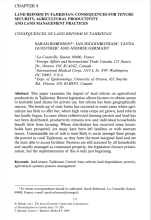Land Library Search
Through our robust search engine, you can search for any item of the over 73,000 highly curated resources in the Land Library.
If you would like to find an overview of what is possible, feel free to peruse the Search Guide.
/ library resources
Showing items 1 through 9 of 40.This paper examines the impact of land reform on agricultural productivity in Tajikistan. Recent legislation allows farmers to obtain access to heritable land shares for private use, but reform has been geographically uneven.
This paper examines the impact of land reform on agricultural productivity in Tajikistan. Recent legislation allows farmers to obtain access to heritable land shares for private use, but reform has been geographically uneven.
Lack of tree regeneration and persistency of species-poor shrublands represent a growing problem across Mediterranean evergreen oak forests. What constrains forest regeneration is poorly understood, and restoration attempts have been largely unsuccessful.
Soil erosion negatively affects crop yields and may have contributed to the collapse of ancient civilizations. Whether erosion may have such an impact on modern societies as well, is subject to debate.
Stream water exports of nutrients and pollutants to water bodies integrate internal and external watershed processes that vary in both space and time.
The magnitude of the environmental and social consequences of soil erosion and land degradation in semiarid areas of the Mediterranean region has long been recognized and studied.
In polygynous mammals, males are usually responsible for gene flow while females are predominantly philopatric. However, there is evidence that in a few mammalian species female offspring may disperse to avoid breeding with their father when male tenure exceeds female age at maturity.
Habitat loss and fragmentation are known to reduce patch sizes and increase their isolation, consequently leading to modifications in species richness and community structure. Calcareous grasslands are among the richest ecosystems in Europe for insect species.
Arbuscular mycorrhizal (AM) fungal diversity was investigated in non-grazed, restored and over-grazed (fenced) plots of a grassland in the Inner Mongolia steppe. Plant cover and variety differ between the plots, being highest in the non-grazed to lowest in the over-grazed plots.



